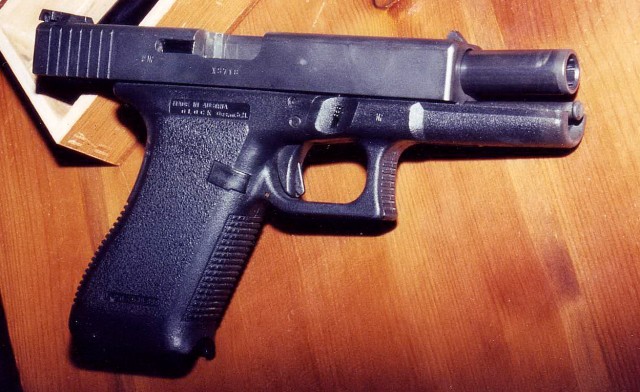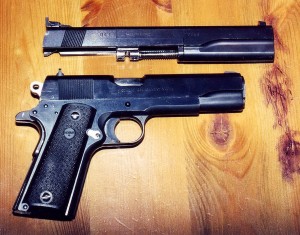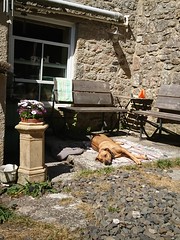Glocks, Brownings and Delays

I was listening to the radio this morning and thinking what a joy it was to hear something sensible on guns. For a bit. Well, it made a change.
The trouble is, journalists really do have absolutely no idea what they are talking about. The piece began by saying that the British Army has at last realised that the Browning Hi-Power was a little bit long in the tooth.
Actually, that doesn’t matter a damn. The age of a gun is no issue. As the reporter did finally say, the thing was that the gun was costing a bit to maintain now. Well, that’s no news. Hi-Powers were the invention of the brilliant John Moses Browning, who gave us so many iconic guns, from Winchester repeating rifles, to the Colt Automatic, the Browning Automatic Rifle, shotguns and many types of pistol. But they were first produced back in about 1935 (from memory) and used by the Wehrmacht in WWII. However, their age in design terms means nothing. They were reliable 9mm sidearms.
The maintenance is a problem, though. I used to have a Colt .45 Auto which I shot competitively, and went from that to a Para-Ordnance .45 because of the greater magazine capacity, but it was in effect the same gun. Reliable, strong and accurate, both were a pleasure to shoot. But although they were mass-produced, anyone who has worked on a Colt or Browning knows the little quibbles with sears and triggers. The problem being, you replace a worn piece, and suddenly you could have a machine gun on your hands. If the sear is ground a little too much, the gun would go full auto and spray bullets down the line with gay abandon. A slight shock to any shooter! Give a gun like that to a squaddie, and you’re asking for some trouble.
Browning was an inventive genius, but Glock was a mechanical and plastics genius. He took Browning’s basic concept of a locking barrel in a gun and refined and refined and refined. When his first pistols appeared in about 1982, he had taken the idea of the self-loading pistol and cut it back to the absolute bare essentials. In so doing, he created a gun that was a dream to shoot: easy, accurate and very fast. It also just happened to be reliable and safe compared with older guns.
Just to take one example: the American Army chose in the 80s to modernise their handguns and discarded their old warhorse the Colt 1911A1 in .45
ACP, a lovely gun, but one showing its age. They moved to the more modern Beretta 92, a gun made famous in films such as Lethal Weapon. This gun is pretty much an evolution of older Beretta types, and the family history is recognisable. It has 70 components. Which is very good. From memory, their old Colts had 67. However, for reliability you want fewer parts. The fewer the better, and this is where Gaston Glock was so bright. By redesigning aspects like the trigger mechanism, he brought the Glock’s parts down to 34. And all are precisely manufactured, so you can remove the trigger mechanism from one and place it in another, and the gun will fire immediately, safely, without going full auto. All parts are interchangeable. It is a squaddie’s dream.
But the report in today’s BBC prpogramme went on to talk about safety. They said that a Browning could take up to four seconds to fire, because (horror of horrors) the shooter may find it hard to turn off the safety. What complete journalistic balls!
I will admit to some bias here. I have shot several Brownings. They were, to me as a shooter, one of the iconic weapons of the 20th Century: beautifully designed, attractive, light. I was delighted to shoot one, just as I was the first time I handled a Webley Fosberry, or the Mauser Broomhandle, or the Luger. And God, what a disappointment!
The thing was clunky. The balance was awful, and the grip felt somehow plain wrong in my hand. It was lovely to look at, but I found it hard to hit a target under competitive conditions. It was such a sad surprise for me – but for a soldier who has to depend upon it, it could mean the difference between life and death.
However, replacing it with even the near-perfect Glock isn’t enough.
When I did my first pistol training on the Colt (which was the precursor to the Browning Hi-Power, with the same safety systems etc) I learned in one day how to draw and fire two shots accurately in less than one second. The failing here is not one of the guns’ ability, but the lack of training and support in the Army. If our soldiers were given more time with their firearms, were given more ammunition to practise with, they would soon be able to fire confidently and accurately. In the good old days when there were gun laws that allowed safe target shooting in the UK, I regularly shot with Army and Police shooters. They were able to improve their safety and accuracy by shooting with competitive shooters. Now, sadly, they are dependent upon a niggardly government. Soldiers are allowed a few rounds in practice before going to Afghanistan, police get (usually, depending on the force) 25 about rounds every two weeks.
Before, to maintain their skills these same officers would routinely shoot 4-600 rounds every weekend. They were safer and so were we the public. But now, when out of uniform, they are not allowed to shoot. They are not allowed to buy their own ammo, and we are all less safe because of it.
But at least, at last, our soldiers will have a sidearm which they can use to protect themselves.





Michael,
Many thanks for this detailed article. In all the time I was in the armed forces (Navy), the only personal weapons I got to shoot (occasionally) were the naval equivalent of the Sten with a name like Lanchester from memory, and of course the old Lee-enfield and SLR. Never once did I get to handle any form of pistol :)
LikeLike
Strange, isn’t it? Pistols are designed purely for self-defence, yet they’re the demonized weapons generally. Ideal for naval action, lighter and easier to carry, and quick to deploy against seaborne attack. Our military are twits, though (the senior folks, that is!)
LikeLike
Hi Michael,
A well written article and very true. I spent some time in the Armed services and was lucky enough to fire most calibers from .22 through to .50. However, during our training to go to battle , we often only had a few (5) blank rounds and had to spend the rest of the time yelling Bang at each other.. What a joke, we were trained all right, but not in a good way, we ended up with platoons of cynics, who were disillusioned about the military and the government.
LikeLike
I’ve heard of situations like that. Absolutely daft. I was talking to soldiers recently and they told me that the allocation for troops to Afghan was 50 rounds to practise. It’s no wonder they cannot use their guns to defend themselves. It’s criminal to send troops out without giving them a chance to use their guns.
LikeLike
That’s shocking, I had no idea they were sent off so unprepared :( Neither did I know how easy it was to turn a pistol into an automatic!
LikeLike
Very easy – very dangerous!
LikeLike
I must say – you are a man full of surprises! Who knew you had been a competitive shooter?
LikeLike
I am, as they say, a man of hidden shallows!
LikeLike